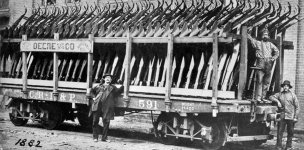PTmowerMech
Lawn Addict
- Joined
- Apr 16, 2018
- Threads
- 401
- Messages
- 3,053
First Steel Plough

This Day In History May 6 1837 US blacksmith John Deere creates the first steel plough in Grand Detour, Illinois
In 1837, John Deere, was a typical blacksmith turning out hay forks, horseshoes, and other essentials for life on the prairie.
Then one day, a broken steel sawmill blade gave him an opportunity. He knew well the back-breaking difficulty of farmers near his home in Grand Detour, Illinois. While plowing, they often interrupted their work to scrape the sticky prairie soil from their cast-iron plows. He envisioned that soil sliding easily off of a highly polished steel moldboard. With steel scarce in the area, Deere acquired a broken steel saw blade, and from it crafted a new type of moldboard plow.
Now, nearly two centuries later, the company that grew out of the success of this innovative plow continues to manufacture advanced equipment for those whose commitment to the land runs deep.
While the original plow could only do a fraction of the work farmers can tackle with modern tillage equipment, it was high-tech at the time. Testing by curator Edward Kendall of the Smithsonian Institution of an 1838 John Deere plow revealed the innovative material, and design, of Deere's early plows. Historian Wayne Broehl, Jr. reiterated, writing that "Deere must have given a great deal of thought to the shape, to the special curve of his moldboard, for its exact contours would determine just how well the soil would be turned over after the share had made the cut."
Over the next two decades, Deere built strong supply and distribution channels, and continually improved his product based on suggestions from customers. His research paid off and by 1849 his business was booming – he produced 2,000 plows that year.
Deere continued to expand his operation and he was soon producing several different plows – an 1857 advertisement mentions nine models. Most were similar in design, but different in size or material. After a visit in 1868, a Chicago newspaper wrote that "John Deere may be called a pioneer, if not the pioneer, plow manufacturer of Illinois..." The paper concluded that "all plow makers respect and honor him for his skill and success, and conceded the service he has rendered Western agriculture by his efforts."
John Deere spent part of his retirement serving as Mayor of Moline, and running his Alderney Hill Farm in Moline. During his lifetime, the walking plow remained the company's core product, supplemented by riding plows, corn planters, wagons and more.
Today, more than 175 years after John Deere created his steel plow, the company provides advanced products and services for those whose work is linked to the land, including a few very modern variations on John Deere's original plow.

This Day In History May 6 1837 US blacksmith John Deere creates the first steel plough in Grand Detour, Illinois
In 1837, John Deere, was a typical blacksmith turning out hay forks, horseshoes, and other essentials for life on the prairie.
Then one day, a broken steel sawmill blade gave him an opportunity. He knew well the back-breaking difficulty of farmers near his home in Grand Detour, Illinois. While plowing, they often interrupted their work to scrape the sticky prairie soil from their cast-iron plows. He envisioned that soil sliding easily off of a highly polished steel moldboard. With steel scarce in the area, Deere acquired a broken steel saw blade, and from it crafted a new type of moldboard plow.
Now, nearly two centuries later, the company that grew out of the success of this innovative plow continues to manufacture advanced equipment for those whose commitment to the land runs deep.
While the original plow could only do a fraction of the work farmers can tackle with modern tillage equipment, it was high-tech at the time. Testing by curator Edward Kendall of the Smithsonian Institution of an 1838 John Deere plow revealed the innovative material, and design, of Deere's early plows. Historian Wayne Broehl, Jr. reiterated, writing that "Deere must have given a great deal of thought to the shape, to the special curve of his moldboard, for its exact contours would determine just how well the soil would be turned over after the share had made the cut."
Over the next two decades, Deere built strong supply and distribution channels, and continually improved his product based on suggestions from customers. His research paid off and by 1849 his business was booming – he produced 2,000 plows that year.
Deere continued to expand his operation and he was soon producing several different plows – an 1857 advertisement mentions nine models. Most were similar in design, but different in size or material. After a visit in 1868, a Chicago newspaper wrote that "John Deere may be called a pioneer, if not the pioneer, plow manufacturer of Illinois..." The paper concluded that "all plow makers respect and honor him for his skill and success, and conceded the service he has rendered Western agriculture by his efforts."
John Deere spent part of his retirement serving as Mayor of Moline, and running his Alderney Hill Farm in Moline. During his lifetime, the walking plow remained the company's core product, supplemented by riding plows, corn planters, wagons and more.
Today, more than 175 years after John Deere created his steel plow, the company provides advanced products and services for those whose work is linked to the land, including a few very modern variations on John Deere's original plow.
